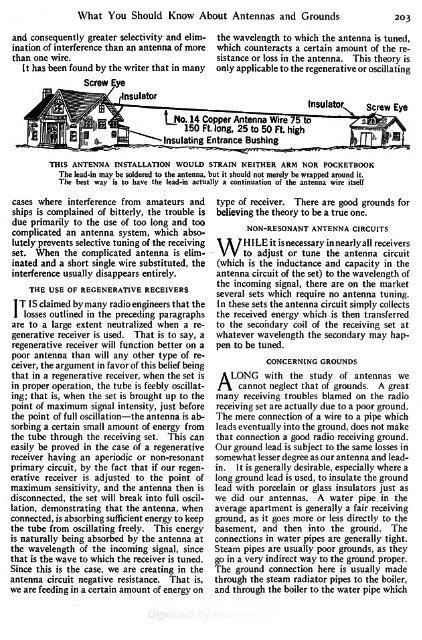Radio Broadcast - 1924, January - 84 Pages, 8.2 ... - VacuumTubeEra
Radio Broadcast - 1924, January - 84 Pages, 8.2 ... - VacuumTubeEra
Radio Broadcast - 1924, January - 84 Pages, 8.2 ... - VacuumTubeEra
Create successful ePaper yourself
Turn your PDF publications into a flip-book with our unique Google optimized e-Paper software.
Screw EyeInsulatorWhat You Should Know About Antennas and Grounds 203and consequently greater selectivity and eliminationof interference than an antenna of morethan one wire.It has been found by the writer that in manythe wavelength to which the antenna is tuned,which counteracts a certain amount of the resistanceor loss in the antenna. This theory isonly applicable to the regenerative or oscillating[__No. 14 Copper Antenna Wire 75 to150 Ft. long, 25 to 50 Ft. highInsulating Entrance BushingInsulatorScrew EyeTHIS ANTENNA INSTALLATION WOULD STRAIN NEITHER ARM NOR POCKETBOOKThe lead-in may be soldered to the antenna, but it should not merely be wrapped around it.The best way is to have the lead-in actually a continuation of the antenna wire itselfcases where interference from amateurs andships is complained of bitterly, the trouble isdue primarily to the use of too long and toocomplicated an antenna system, which absolutelyprevents selective tuning of the receivingset. When the complicated antenna is eliminatedand a short single wire substituted, theinterference usually disappears entirely.THE USE OF REGENERATIVE RECEIVERSthat theIS claimed by many radio engineersITlosses outlined in the preceding paragraphsare to a large extent neutralized when a regenerativereceiver is used. That is to say, aregenerative receiver will function better on apoor antenna than will any other type of receiver,the argument in favor of this belief beingthat in a regenerative receiver, when the set isin proper operation, the tube is feebly oscillat-to theing; that is, when the set isbrought uppoint of maximum signal intensity, just beforethe point of full oscillation the antenna is absorbinga certain small amount of energy fromthe tube through the receiving set. This caneasily be proved in the case of a regenerativereceiver having an aperiodic or non-resonantprimary circuit, by the fact that if our regenerativereceiver isadjusted to the point ofmaximum sensitivity, and the antenna then isdisconnected, the set will break into full oscillation,demonstrating that the antenna, whenconnected, is absorbing sufficient energy to keepthe tube from oscillating freely. This energyisnaturally being absorbed by the antenna atthe wavelength of the incoming signal, sincethat is the wave to which the receiver is tuned.Since this is the case, we are creating in theantenna circuit negative resistance. That is,we are feeding in a certain amount of energy ontype of receiver. There are good grounds forbelieving the theory to be a true one.NON-RESONANT ANTENNA CIRCUITSit isnecessaryWHILE in nearly all receiversto adjust or tune the antenna circuit(which is the inductance and capacity in theantenna circuit of the set) to the wavelength ofthe incoming signal, there are on the marketseveral sets which require no antenna tuning.In these sets the antenna circuit simply collectsthe received energy which is then transferredto the secondary coil of the receiving set atwhatever wavelength the secondary may happento be tuned.CONCERNING GROUNDSALONG with the study of antennas wecannot neglect that of grounds. A greatmany receiving troubles blamed on the radioreceiving set are actually due to a poor ground.The mere connection of a wire to a pipe whichleads eventually into the ground, does not makethat connection a good radio receiving ground.Our ground lead is subject to the same losses insomewhat lesser degree as our antenna and leadin.It isgenerally desirable, especially where along ground lead is used, to insulate the groundlead with porcelain or glass insulators just aswe did our antennas. A water pipe in theaverage apartment is generally a fair receivingground, as itgoes more or less directly to thebasement, and then into the ground. Theconnections in water pipes are generally tight.Steam pipes are usually poor grounds, as theygo in a very indirect way to the ground proper.The ground connection here isusually madethrough the steam radiator pipes to the boiler,and through the boiler to the water pipe which
















